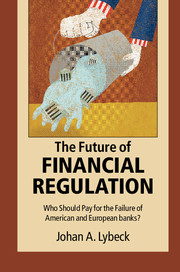Book contents
- Frontmatter
- Dedication
- Contents
- List of figures
- List of tables
- List of boxes
- Preface
- Acknowledgements
- List of abbreviations
- Introduction
- Part I A chronological presentation of crisis events January 2007 – December 2014
- Part II Bail-out and/or bail-in of banks in Europe: a country-by-country event study on those European countries which did not receive outside support
- 1 United Kingdom: Northern Rock, Royal Bank of Scotland (RBS), Lloyds Banking Group
- 2 Germany: IKB, Hypo Real Estate, Commerzbank, Landesbanken
- 3 Belgium, France, Luxembourg: Dexia
- 4 Benelux: Fortis, ING, SNS Reaal
- 5 Italy: Monte dei Paschi di Siena
- 6 Denmark: Roskilde Bank, Fionia Bank and the others vs. Amagerbanken and Fjordbank Mors
- Part III Bail-out and/or bail-in of banks in Europe: a country-by-country event study on those European countries which received IMF/EU support
- Part IV The TARP program and the bailing out (and bailing in) of US banks
- Part V Summary of the micro studies
- Part VI Political and regulatory responses to the crisis: to bail out or to bail in, that's the question
- Conclusion: toward host-country supervision and resolution?
- Addendum
- Bibliography
- Index
4 - Benelux: Fortis, ING, SNS Reaal
from Part II - Bail-out and/or bail-in of banks in Europe: a country-by-country event study on those European countries which did not receive outside support
Published online by Cambridge University Press: 05 February 2016
- Frontmatter
- Dedication
- Contents
- List of figures
- List of tables
- List of boxes
- Preface
- Acknowledgements
- List of abbreviations
- Introduction
- Part I A chronological presentation of crisis events January 2007 – December 2014
- Part II Bail-out and/or bail-in of banks in Europe: a country-by-country event study on those European countries which did not receive outside support
- 1 United Kingdom: Northern Rock, Royal Bank of Scotland (RBS), Lloyds Banking Group
- 2 Germany: IKB, Hypo Real Estate, Commerzbank, Landesbanken
- 3 Belgium, France, Luxembourg: Dexia
- 4 Benelux: Fortis, ING, SNS Reaal
- 5 Italy: Monte dei Paschi di Siena
- 6 Denmark: Roskilde Bank, Fionia Bank and the others vs. Amagerbanken and Fjordbank Mors
- Part III Bail-out and/or bail-in of banks in Europe: a country-by-country event study on those European countries which received IMF/EU support
- Part IV The TARP program and the bailing out (and bailing in) of US banks
- Part V Summary of the micro studies
- Part VI Political and regulatory responses to the crisis: to bail out or to bail in, that's the question
- Conclusion: toward host-country supervision and resolution?
- Addendum
- Bibliography
- Index
Summary
The Dutch story
As shown above in Figures 10 and 11, the Netherlands has a strong presence in banking but also a highly concentrated one. With banking assets at 400 percent of GDP, it exceeds France, Germany or Belgium but not the UK or Luxembourg. In 2007, three of the 30 largest banks in the world by total assets were Dutch: ING, Rabobank and the then still-existing ABN AMRO. After the demise of the latter, the classification by the Financial Stability Board in 2012 of Globally Systemically Important Financial Institutions (G-SIFI) contained only one Dutch name, ING. The degree of concentration is high with the top five banks having 80 percent of all banking assets. Indeed, there are only some 20 banks altogether, to be contrasted with over 1,700 in neighboring Germany and, indeed, over 200 banks in (almost) neighboring Denmark, a country half the size of the Netherlands in terms of population.
As a seafaring and trading nation, it is hardly surprising that the Dutch should have a tradition in finance. Indeed, the Amsterdam Stock Exchange, started in 1602, is usually regarded to be the world's oldest stock exchange and the Amsterdamsche Wisselbank (Bank of Amsterdam), started in 1609, one of the world's oldest commercial banks. But just like the story of present-day Dutch banking, there have also been periods of crises, such as the tulipmania speculation and crash in the 1630s and the bankruptcy of the Dutch state in 1810, occasioned by the disastrous effect on Dutch trade of Napoleon's Continental System.
Fortis
Established formally in 1990 with the merger of Dutch insurer AMEV, Belgian insurer AG and VSB, a Dutch bank, its real expansion began a few years later with the purchase in 1993 from the Belgian government of the Caisse Générale d’Épargne et de Retraite (CGER in French, ASLK in Flemish). In 1999, Fortis became the sole owner of CGER, which in the meantime had bought the Société National de Crédit à l'Industrie (SNCI). The year before, 1998, Fortis had bought Générale de Banque, its major competitor in Belgium. In 10 years, the group's total assets multiplied 10 times.
At the time, Fortis was the first major financial company in the Benelux countries to become a universal bank after changed legislation in 1991, encompassing retail banking, private banking, merchant (investment) banking as well as insurance.
- Type
- Chapter
- Information
- The Future of Financial RegulationWho Should Pay for the Failure of American and European Banks?, pp. 199 - 208Publisher: Cambridge University PressPrint publication year: 2016
- 1
- Cited by



